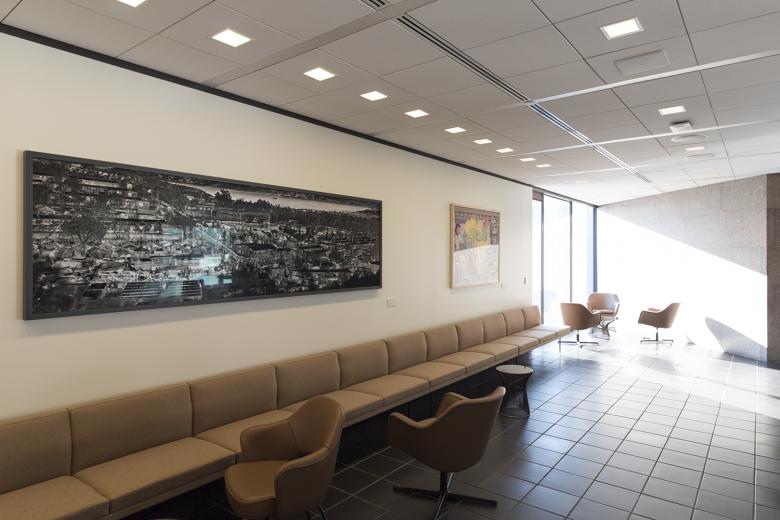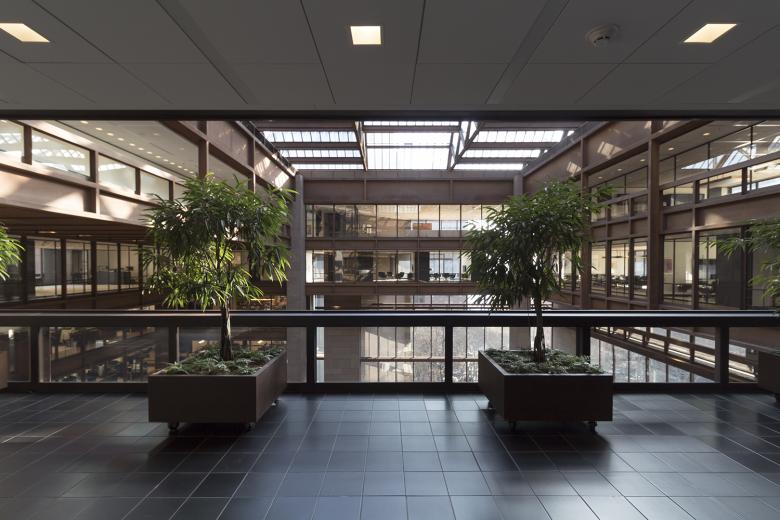Inside the Ford Foundation, 50 Years Later
All photographs by John Hill/World-Architects
The Ford Foundation building in Midtown Manhattan, designed by Kevin Roche John Dinkeloo and Associates, celebrated its 50th anniversary this year with a careful $205 million renovation by Gensler. World-Architects got a tour of the building that just reopened as the Ford Foundation Center for Social Justice.
The Ford Foundation opened its doors to some journalists yesterday for a press conference and tour of the twelve-story building that was completed in 1968. Arriving too late for the press conference due to subway issues, I checked in at security, took the elevator to the 10th floor, and then looked around for the tour group. Walking along the edge of the full-height atrium, another delayed journalist commented to me that we should be able to find them easily since the building is set up like a Panopticon, referring to the 18th-century prisons that had circular plans with cells on the perimeter and a central guard watchtower. He's right, given that the once-executive tenth and eleventh floors extend out over the atrium, looking back at the office floors: a corporate-philanthropic Panopticon that Kevin Roche nevertheless intended to foster a sense of community rather than control. Yet, as will be seen in the following photos from the tour (yes, we managed to find the group), the all-seeing effect is one aspect of the original that has changed in Gensler's subtle, sensitive renovation of the Ford Foundation.


The renovation adds about 50% more publicly accessible spaces to the 415,000-sf building, from 53,600 sf to 81,000 sf. One of those spaces is a new gallery, set to open in March 2019. Here is the walkway leading to the gallery, revealing a view of the terraced garden formerly invisible to the public.
The publicly accessible atrium garden, originally designed by Dan Kiley, has been renovated by Jungles Studio in collaboration with SiteWorks. Kiley's original design was removed a long time ago in favor of lush tropical plants more suited to the greenhouse-like environment. Landscape architect Raymond Jungles has brought the landscape closer to Kiley's intention, using trees with higher canopies to create views across the atrium at eye level.
This view of the skylit atrium from the sixth floor reveals one of the two L-shaped, glazed-in wings of the office floors on the right, and the two "Panopticon" floors at 10 and 11 in the upper-left corner. Levels two and three, portions of them visible at bottom-right, are being given over to other philanthropic tenants.
Gensler has laid out the floors with walkways along the atrium's glass walls. This gives everybody working in the building views of the atrium and reduces the Panopticon effect by moving open-plan workspaces away from the atrium. Parquet floors, like those here, were restored to their original appearance after whitening over the last five decades.
Gensler's renovation boasts the restoration of more than 1,500 pieces of furniture. Here is the lounge near the top of the building.
Gensler's renovation follows the original six-foot grid module, both at the floor and the ceiling. The way the windows and walls fit into the grid is visible in this view of an office floor.
Visible in this view across the atrium is the way the refurbished lighting in the offices illuminates the ceilings. Formerly walled-off offices have been opened up throughout the building.
A major chunk of Gensler's renovation was aligning the 50-year-old building with current building codes. This meant, among other things, retaining the sliding wall panels and metal balustrades (visible at center and at left) but locking the panels shut for fire and life safety. Visible at right through the glass walls is a new conference room dedicated to Nelson Mandela.
The west edge of the tenth floor is open to the atrium, making for a dramatic view across the twelve-story space. Once a restricted area available only to the Ford Foundation president and those allowed to visit him, the new conference areas on the top two floors are now available to organizations aligned with the mission of the Ford Foundation.
The eleventh floor circles the atrium fully below the sawtooth skylight.
Looking back toward the office floors from the eleventh-floor arm extending over the atrium.
This last view, from the same position as the previous photo, illustrates the walkways along the glass walls and the setback workstations spread across the now-open office floors.












